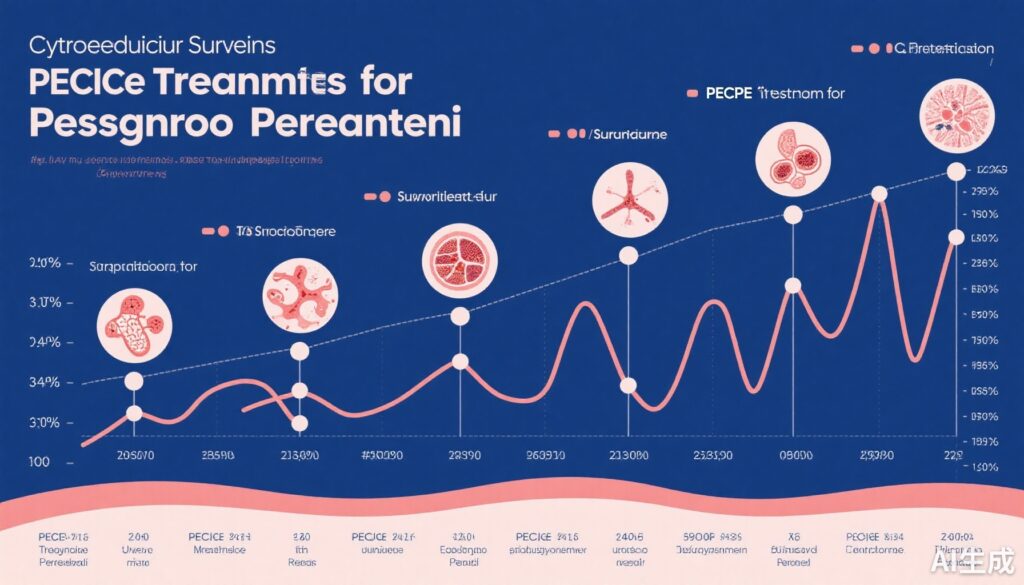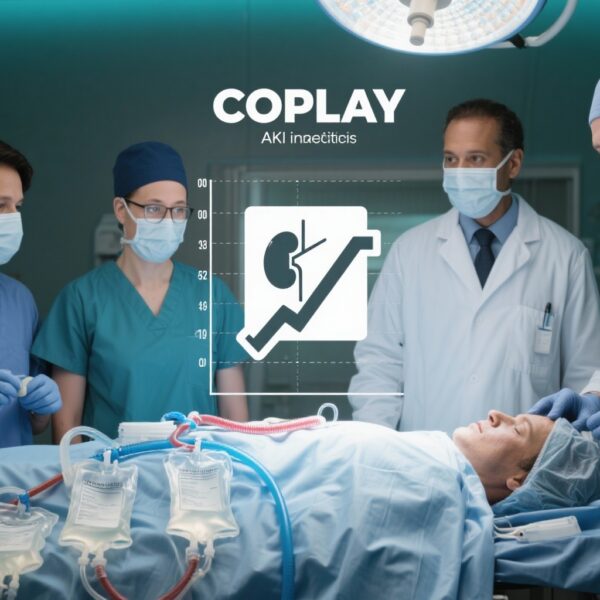Highlights
- Comprehensive 22-year singular institutional data affirm CRS and HIPEC yield promising long-term survival for PMP, with 62% 5-year overall survival.
- Histopathological grade, completeness of cytoreduction (CC0-1), and tumor markers such as CEA significantly influence prognosis.
- Recent studies favor cisplatin plus docetaxel HIPEC regimens, urine-guided intraoperative hydration reduces AKI risk, and perioperative nutritional support enhances recovery.
- Nomograms and prognostic classifications (PSOGI) improve individual patient risk stratification and clinical decision-making.
Background
Pseudomyxoma peritonei (PMP) is a rare clinical syndrome predominantly originating from ruptured appendiceal mucinous neoplasms, characterized by progressive mucinous ascites and peritoneal dissemination. Historically associated with poor prognosis if untreated, the advent of cytoreductive surgery (CRS) combined with hyperthermic intraperitoneal chemotherapy (HIPEC) has markedly transformed survival outcomes. CRS aims to achieve macroscopic complete tumor resection, while HIPEC delivers heated chemotherapy directly into the peritoneal cavity to eradicate microscopic residual disease. Given the rarity and clinical complexity of PMP, long-term outcomes and prognostic determinants remain an active area of investigation.
Key Content
1. Long-Term Survival and Prognostic Factors: Insights from a 22-Year Single Centre (Queen Elizabeth Hospital, Adelaide)
The retrospective analysis by Kaur et al. (2025) reported outcomes of 108 patients undergoing 121 CRS procedures with adjunctive HIPEC over 22 years (2002-2024). Key findings included:
- Complete cytoreduction (CC0-1) was achieved in 85.9% cases—consistent with high-volume center standards.
- Median survival in patients receiving HIPEC was 92 months (approx. 7.7 years), with 5-year overall survival (OS) of 62% and median recurrence-free survival (RFS) of 109 months.
- Significant survival difference between low-grade PMP (64% 5-year OS) and high-grade PMP without signet-ring cells (30% 5-year OS).
- Independent prognostic factors identified included high-grade histology and carcinoembryonic antigen (CEA) levels ≥ 5, correlating with worse OS.
These results underscore the efficacy of CRS + HIPEC in achieving durable long-term survival, aligning with outcomes from high-volume centers and underscoring the feasibility of comparable results in lower-volume settings while ensuring patient safety.
2. HIPEC Regimen Optimization
A recent 2025 retrospective propensity score-matched study (PMID: 40289248) comparing cisplatin plus docetaxel (CD) versus cisplatin plus mitomycin C (CM) HIPEC regimens demonstrated:
- Significantly longer median OS in the CD group (156.3 months vs. 60.9 months, p=0.018).
- Similar safety profiles between regimens.
- Enhanced benefit of CD regimen particularly pronounced in patients with PCI ≥ 27, incomplete cytoreduction (CC 2/3), high-grade pathology, and elevated tumor markers.
This suggests personalized HIPEC regimens may optimize survival, with cisplatin-docetaxel combination representing a promising alternative to mitomycin C-based protocols.
3. Surgical Morbidity and Perioperative Management
Management of postoperative complications and optimizing recovery is critical:
- Urine-guided intraoperative hydration significantly reduced the incidence of acute kidney injury (AKI) after CRS and cisplatin-based HIPEC, lowering AKI by over 40% without compromising safety (PMID: 40801363).
- Enteral nutrition (EN) compared to total parenteral nutrition (TPN) has shown to improve postoperative immune parameters and reduce complications and hospital stay in PMP patients undergoing CRS-HIPEC (PMID: 35694101).
- Bilateral erector spinae plane block (ESPB) was demonstrated to improve postoperative analgesia and reduce opioid consumption, enhancing perioperative pain management strategies (PMID: 39402455).
4. Histopathological Classification and Risk Stratification
The PSOGI consensus pathological classification stratifies PMP into distinct prognostic groups:
- Low-grade mucinous carcinoma peritonei (LGMCP) shows superior OS and DFS compared to high-grade MCP (HGMCP) and HGMCP with signet ring cells (HGMCP-SRC).
- Although univariate analyses reveal significant survival differences across PSOGI subtypes, multivariate analyses sometimes attenuate this association, highlighting the importance of integrating cytoreduction completeness and other variables (PMID: 37304162, 35557579).
- Nomograms developed using variables such as tumor grade, PCI, CEA, and completeness of cytoreduction provide precise individual predictions of OS and disease-free survival (DFS), supporting personalized management (PMID: 36920381, 34480280).
5. Clinical Outcomes in Broader Registries and Multicenter Studies
Data from multi-institutional registries illustrate consistent findings:
- Indian HIPEC Registry (PMID: 37359912): PMP patients undergoing CRS +/- HIPEC demonstrated median OS of 56 months and 5-year OS ~38%, with HIPEC and PMP origin independently predictive of improved survival.
- Dutch CRS-HIPEC Quality Registry (PMID: 39241538) reported 82% complete cytoreduction rate for PMP, with manageable postoperative morbidity and mortality, reflecting real-world reproducibility of CRS-HIPEC benefits.
Expert Commentary
CRS combined with HIPEC remains the cornerstone for PMP management, with volume-outcome relationships favoring high-volume centers. However, the 22-year single institution experience from TQEH demonstrates that specialized centers with moderate caseloads can achieve comparable survival and recurrence outcomes while ensuring patient safety.
Histopathologic grade and CEA levels have consistent prognostic relevance, guiding patient counseling and follow-up frequency. The selection of HIPEC agents is evolving, with evidence favoring cisplatin-docetaxel regimens in certain subgroups, underscoring the necessity of personalized intraoperative chemotherapy strategies.
Perioperative optimization including meticulous fluid management, enhanced analgesic techniques such as ultrasound-guided ESPB, and nutritional support substantially mitigate surgical morbidity, facilitating recovery and potentially improving oncologic outcomes.
Emerging nomograms and PSOGI-based classifications integrate clinical and pathological features to individualize risk prediction, which is pivotal for refining patient selection, tailoring treatment, and designing trials.
Limitations in current literature include retrospective design, heterogeneous protocols, and varying follow-up adherence influencing survival estimates. Prospective, multicentric studies with standardized protocols remain essential to refine treatment algorithms further.
Conclusion
Over two decades, CRS and HIPEC have substantiated their role as effective curative-intent treatments for PMP, achieving substantial long-term survival and recurrence-free intervals. The quality of cytoreduction and tumor biology critically determine outcomes. Recent advancements in HIPEC regimen optimization, perioperative care, and prognostic modeling enhance therapeutic precision and patient-centered care.
Multidisciplinary, experienced teams are imperative to maximize benefits while minimizing risks. Further research should focus on prospective validation of predictive models, perioperative management protocols, and refining HIPEC compositions to augment survival and quality of life in PMP patients.
References
- Kaur H et al. Long-Term Survival Following Cytoreductive Surgery and Hyperthermic Intraperitoneal Chemotherapy (HIPEC) for Pseudomyxoma Peritonei: A 22-Year Single Institution Experience. ANZ J Surg. 2025;95(10):2112-2122. PMID: 40539400.
- Cisplatin + docetaxel improves survival over cisplatin + mitomycin C in HIPEC for PMP: Int J Hyperthermia. 2025;42(1):2467296. PMID: 40289248.
- Effect of Urine-guided Intraoperative Hydration on AKI after CRS + HIPEC: Anesthesiology. 2025;143(5):1242-1254. PMID: 40801363.
- PSOGI Classification and Survival Outcomes in PMP: Pleura Peritoneum. 2023;8(2):65-74. PMID: 37304162.
- Nomograms to Predict Survival in PMP after Completeness of Cytoreduction and HIPEC: JAMA Surg. 2023;158(5):522-530. PMID: 36920381.
- Long-term survival in PMP: World J Surg Oncol. 2023;21(1):347. PMID: 37891655.
- CRS and HIPEC Quality Registries: Eur J Surg Oncol. 2024;50(12):108568. PMID: 39241538.
- Enteral Nutrition and Postoperative Outcomes in PMP Patients: Gland Surg. 2022;11(5):818-825. PMID: 35694101.
- Analgesia with Bilateral ESPB in PMP Surgery: BMC Anesthesiol. 2024;24(1):370. PMID: 39402455.



